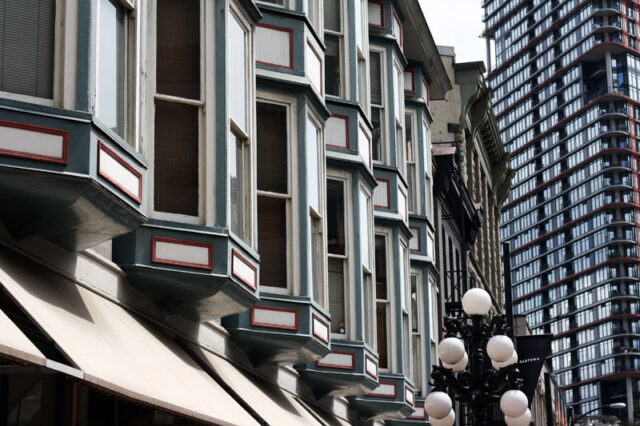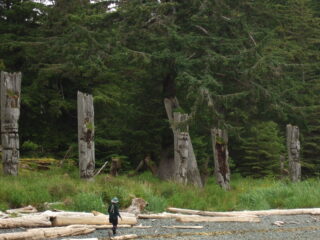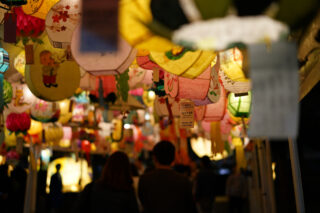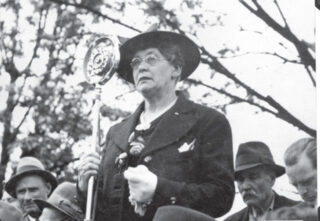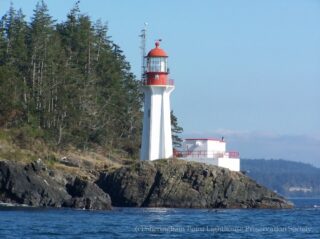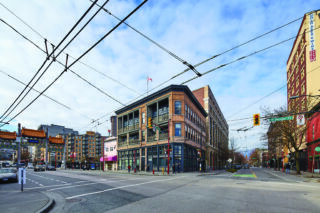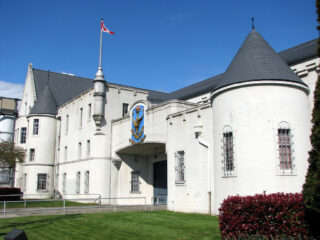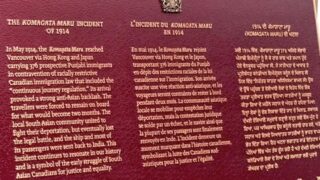Historic places can be recognized and protected by various levels of government and legislation, including international, federal, provincial, and municipal options. Increasingly, non-tangible cultural heritage is receiving recognition both independent from, and in connection with, place such as traditional cultural and spiritual practices, language and food.
Built heritage and archaeological sites receive different treatment in some legislation, including that of British Columbia where a distinction is made between pre-1846 sites and those of a later date.
A historic place can be:
A building or other structure, group of buildings, district, landscape, archaeological site and can include not only the physical but also the non-physical associations of a place such as use, cultural and spiritual values.
International
-
UNESCO
The United Nations Educational, Scientific and Cultural Organization (UNESCO) defines and designates international heritage sites and dictates the regulations and requirements involved in nominating, maintaining and protecting international heritage.
The UNESCO World Heritage List
- Developed by UNESCO, the World Heritage List (WHL) comprises over 1000 natural, cultural, transboundary and mixed sites deemed to be of outstanding universal value.
- It was established by the 1972 World Heritage Convention and accepted by Canada in 1976.
- Sites are nominated to the list by their national governments. Once accepted, they become ‘World Heritage Sites’.
- As of 2021, Canada has 20 sites on the WHL, as well as 11 sites on the tentative list (sites that Canada is considering for nomination).
The UNESCO List of World Heritage in Danger
- This is a sub-list featuring sites that are currently threatened. The purpose of this list is to draw attention to threats and encourage counteractive measures where possible. There are 53 sites on this list as of 2021.
UNESCO List of Intangible Cultural Heritage
- This list is intended to recognize and protect non-physical heritage practices. The Intangible Cultural Heritage List is divided into two types:
- The List of Intangible Cultural Heritage in Need of Urgent Safeguarding
- Representative List of the Intangible Cultural Heritage of Humanity
The UNESCO Register of Good Safeguarding Practices
- This register shares cases where intangible heritage was successfully protected. As of 2021, over 15 cases have been put on the register.
-
ICOMOS
International Council on Monuments and Sites (ICOMOS) is an international, non-governmental organization working for the conservation of monuments and sites around the world. It has a chapter in Canada, based in Ottawa.
- ICOMOS’s list of international charters guides heritage conservation work on buildings, sites, engineering structures, and cultural landscapes.
- ICOMOS is one of the three formal advisory bodies to the World Heritage Committee, the others are the International Union for Conservation of Nature (IUCN) and the International Centre for the Study of the Preservation and Restoration of Cultural Property (ICCROM). It participates in the implementation of the 1972 World Heritage Convention.
- ICOMOS is the professional and scientific advisor to the committee on all aspects of cultural heritage. In particular, it is responsible for the evaluation of all nominations of cultural and mixed properties against the basic criterion of “outstanding universal value” and all other criteria as specified in the convention. (“The Role of ICOMOS in the World Heritage Convention”, ICOMOS, accessed January 17, 2020, https://www.icomos.org/en/what-we-do/image-what-we-do/268-he-role-of-icomos-in-the-world-heritage-convention)
National - Canada
-
Parks Canada
Parks Canada plays a fundamental role in the preservation, recognition and promotion of heritage in Canada.
The Directory of Federal Heritage Designations
- The Directory of Federal Heritage Designations offers a complete list of federally designated heritage places, people, objects, buildings and more. This includes 47 designations within Vancouver of which; 12 are National Historic Sites, 9 are Federal Heritage Buildings, 1 is a Heritage Railway Station, 9 are National Historic Events, and 16 are National Historic People.
The Historic Sites and Monuments Board of Canada
- This board is part of Parks Canada and advises the federal government on the commemoration of nationally significant aspects of Canada’s history.
- 95% of applications for designation are submitted by Canadian individuals and groups.
- Any aspect of Canada’s human history may be considered.
Sites must have a nationally significant impact on Canadian history, or must illustrate a nationally important aspect of Canadian history.
The Canadian Register of Historic Places (CRHP)
- Adminstered by Parks Canada, the register provides a single source of information about all historic places recognized for their heritage value at the local, provincial, territorial and national levels throughout Canada.
-
Built Heritage Designation
Canada has heritage designations for built heritage at the federal level in four main categories:
- National Historic Sites of Canada
- Places of profound importance to Canada. They may be sacred spaces, archaeological sites, battlefields, heritage houses, historic districts, places of scientific discovery, and more.
- There are more than 970 National Historic Sites, 171 of which are administered by Parks Canada. Parks Canada preserves the sites’ cultural resources and promotes their heritage value and national significance.
- Designated Heritage Railway Stations
-
- The Heritage Railway Stations Protection Act (1990) responded to concerns that Canada’s heritage railway stations were not adequately protected.
- The Act dictates that no railway company may in any way alter, demolish or transfer ownership of a designated heritage railway station without the authorization of the Governor in Council.
- To be considered a designated heritage railway station, the station must be owned by a railway company subject to Part III of the Canada Transportation Act and must be more than 40 years old.
- Designated Heritage Lighthouses
-
- The Minister responsible for Parks Canada designates heritage lighthouses on behalf of the Government of Canada.
- The Heritage Lighthouse Protection Act (2008):
- Prevents the unauthorized alteration or disposition of a designated heritage lighthouse.
- Requires that heritage lighthouses be reasonably maintained and altered only in keeping with the Standards and Guidelines for the Conservation of Historic Places in Canada.
- Facilitates sales or transfers of heritage lighthouses to promote an ongoing public purpose while ensuring their long-term protection.
- Designated Federal Heritage Buildings
-
- The primary objective of the Federal Heritage Buildings Review Office (FHRBO) is to assist the federal government in the protection of heritage buildings, in accordance with the Treasury Board Policy on Management of Real Property.
- Federal departments must have FHBRO evaluate the buildings they administer or that they are planning to purchase that are 40 years of age or older to determine their heritage character.
- The directory lists over 1200 Federal Heritage Buildings owned by the federal government.
- National Historic Sites of Canada
-
Intangible Heritage Designations
In addition, Canada also has heritage designations relating to people and events. These are recognized with a physical marker.
Designated National Historic Persons and National Historic Events
- National Historic Persons are people who, through their words or actions, have made a unique and enduring contribution to the history of Canada.
- National Historic Events evoke a moment, episode, movement or experience in the history of Canada.
-
Standards and Guidelines for the Conservation of Historic Places in Canada
First published in 2003 and revised in 2010, the Standards and Guidelines for the Conservation of Historic Places in Canada is the primary guide at the national level for changes to historic places and the impact of proposed work on older buildings, engineering works, landscapes and archaeological sites. The Standards and Guidelines does the following:
- Offers results-oriented guidance for sound decision-making when planning for, intervening on and using historic places.
- Establishes a consistent, pan-Canadian set of conservation principles and guidelines that will be useful to anyone with an interest in conserving Canada’s historic places.
- The definitions in the pan-Canadian document have established the common language for heritage conservation work at all levels of government — municipal, regional, provincial and federal — as well as in private and non-profit sectors across Canada.
Provincial - BC
-
The Heritage Conservation Act (HCA)
In British Columbia, the Heritage Conservation Act outlines the designation and legislation processes involved in the regulation of historic places in British Columbia.
- The Heritage Conservation Act dictates that heritage designation and protection is available to sites in British Columbia pre-dating 1846. However, the Act does not guarantee protection to sites post-dating 1846 or to intangible cultural heritage (e.g. spiritual sites).
- The HCA contains substantial penalties for damage or destruction of a site, including up to two years imprisonment and fines up to $1,000,000.
-
The BC Heritage Branch
The BC Heritage Branch is “the Province’s primary body responsible for the conservation of historic places in British Columbia. It manages the BC Register of Historic Places and develops policy for heritage conservation.”
-
The BC Register of Historic Places (BCRHP)
The Register is the official provincial list of historic places. It includes historic sites protected by the province, as well as those recognized by municipalities. Over 4600 historic places have been included so far. The Register is not currently available to the public in list form, but the Heritage Branch is currently working on ways to make it more accessible.
- Addition to the BC Register of Historic Places:
- When a historic place is recognized or protected through provisions of the Local Government Act, the Heritage Branch is notified within 30 days so that the BC Registrar can add it to the BCRHP.
- There are 50 provincially designated historic places but since the 1990s, the province has transferred heritage designation (protection) tools to the municipal level. As a result, new provincial designations are rare.
- The Heritage Branch has created a community register commemorating sites around BC that are significant to people of different backgrounds and ethnicities. This community register aims to draw attention to sites and monuments beyond those significant in colonial history, however, these sites are not protected to the same extent as those on the BC Register of Historic Places.
- Addition to the BC Register of Historic Places:
-
The BC Archaeology Branch
The Archaeology Branch works under the HCA, and within the BC Ministry of Forests, Lands, Natural Resource Operations and Rural Development to provide accurate, updated archaeological information and to make decisions regarding the granting of permits.
- Archaeological Site Designation:
- Archaeological sites are typically discovered and recorded by archaeologists (with the proper permits) who pass that information on to the Archaeology Branch. The Branch also receives informal information on possible sites from citizens.
- Archaeological Site Designation:
Non-governmental Recognition of Historic Places
-
Community Initiatives
In addition to formal designation and registers, community initiatives can also recognize historic places. An example of this is Vancouver Heritage Foundation’s Places That Matter plaque program, launched in 2011.
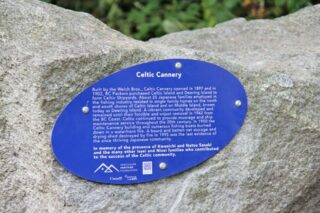
Looking Forward
While dependent on civic leadership and the legislative process, the preservation, conservation and recognition of historic places also occurs through public awareness, appreciation and education. The understanding of cultural heritage is continuously evolving, and legislation varies between cities, provinces, and countries.
The people involved in determining legislation contribute to the type of legislation created. Those impacted by heritage legislation may work to create their own, acknowledging and correcting for areas lacking coverage, information, and protection. Recognition and protection of cultural heritage and historic places can be sought at the community level and it is through these efforts that heritage is often identified and safeguarded.
The tools of recognition outlined here are not exhaustive nor are they static. Diverse stories of importance have often not been well-represented in formal recognitions of heritage, including Indigineous, BIPOC and other historically marginalized communities’ heritage. The continued development of these and new tools must be informed by Canada’s diverse communities and values if they are to adequately recognize and protect heritage places and stories.
Page created July 2021. Please let us know if you have updates or information to add.
We would like to extend our thanks to the following people for their contributions to this page:
Susan Green, Registrar with the BC Heritage Branch, for information on the BC Register of Historic Places.
Judy Oberlander, Heritage Consultant, for information on ICOMOS, the Standards & Guidelines, and editorial contributions.
Hugh McLean, Heritage Planner, for information on the Standards & Guidelines.
Charlotte Bailey, VHF Intern – Heritage Resources Assistant, 2018-19, with support from Young Canada Works (Government of Canada).
Further Reading
-
Resources
BCAPA: Archaeology in BC. https://www.bcapa.ca/archaeology/
City of Vancouver: Regulating development in Vancouver’s heritage areas. https://vancouver.ca/home-property-development/vancouvers-heritage-areas.aspx
City of Vancouver: Vancouver Heritage Program. https://vancouver.ca/home-property-development/heritage.aspx
City of Vancouver: 2021 Vancouver Heritage Register. https://guidelines.vancouver.ca/policy-vancouver-heritage-register.pdf
First Peoples’ Cultural Council. Recognizing And Including Indigenous Cultural Heritage In B.C. https://fpcc.ca/resource/heritage-policy-paper/
ICOMOS: The role of ICOMOS in the World Heritage Convention. https://www.icomos.org/en/what-we-do/image-what-we-do/268-he-role-of-icomos-in-the-world-heritage-convention
Government of British Columbia: Heritage Conservation Act [RSBC 1996] Chapter 187. http://www.bclaws.ca/civix/document/id/complete/statreg/96187_01
Government of British Columbia: Historic Places. Conserving Buildings and Properties. https://www2.gov.bc.ca/gov/content/governments/celebrating-british-columbia/historic-places/conserving-buildings-properties
Government of British Columbia: Provincial and Federal Registers. BC Register of Historic Places. https://www2.gov.bc.ca/gov/content/governments/celebrating-british-columbia/historic-places/provincial-federal-registers
Government of British Columbia: Vancouver Charter. SBC 1953 Chapter 55. http://www.bclaws.ca/civix/document/id/complete/statreg/vanch_00
Parks Canada: Directory of Federal Heritage Designations. https://www.pc.gc.ca/en/culture/dfhd
Parks Canada: A Guide to Working with the Federal Heritage Buildings Review Office. https://www.historicplaces.ca/media/7313/fhbro_manual_parks%20canada.pdf
Parks Canada: Standards and Guidelines for the Conservation of Historic Places in Canada. https://www.historicplaces.ca/media/18072/81468-parks-s+g-eng-web2.pdf
Parks Canada: World Heritage Sites in Canada. https://www.pc.gc.ca/en/culture/spm-whs/a-propos-about
UNESCO: World Heritage Centre. World Heritage List. https://whc.unesco.org/en/list/
UNESCO: Intangible Cultural Heritage. Browse the Lists of Intangible Cultural Heritage and the Register of good safeguarding practices. https://ich.unesco.org/en/lists
Vancouver Heritage Foundation: Places that Matter. https://www.placesthatmatter.ca/
Walker, Alexa: New First Nations Heritage Planning Toolkit Released in British Columbia. https://www.sfu.ca/ipinch/news/ip-and-cultural-heritage-news/new-first-nations-heritage-planning-toolkit-released-british-colu/#
